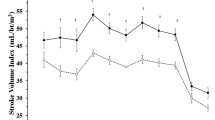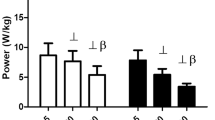Summary
In order to test for possible sex differences in endurance capacity, groups of young, physically active women (n=6) and men (n=7) performed bicycle ergometer exercise at 80% and 90% of their maximal oxygen uptakes (\(\dot V_{{\text{O}}_{\text{2}} {\text{max}}}\)). The groups were matched for age and physical activity habits. At 80%\(\dot V_{{\text{O}}_{\text{2}} {\text{max}}}\) the women performed significantly longer (P<0.05), 53.8±12.7 min vs 36.8±12.2 min, respectively (means ± SD). Mid-exercise and terminal respiratory exchange ratio (R) values were significantly lower in women, suggesting a later occurrence of muscle glycogen depletion as a factor in their enhanced endurance. At 90%\(\dot V_{{\text{O}}_{\text{2}} {\text{max}}}\) the endurance times were similar for men and women, 21.2±10.3 min and 22.0±5.0 min, respectively. The blood lactate levels reached in these experiments were only marginally lower (mean differences 1.5 to 2 mmol·l−1) than those obtained at\(\dot V_{{\text{O}}_{\text{2}} {\text{max}}}\), suggesting high lactate levels as a factor in exhaustion. The changes in body weight during the 80% experiments and the degree of hemoconcentration were not significantly different between men and women.
Similar content being viewed by others
References
Adams RP, Welch HG (1980) Oxygen uptake, acid-base status, and performance with varied inspired oxygen fractions. J Appl Physiol Respir Environ Exercise Physiol 49: 863–868
American College of Sports Medicine (1979) Opinion statement on the participation of the female athlete in long-distance running. Med Sci Sports 11: ix-xi
Bass A, Vondra K, Rath R, Vitek V (1975) M. femoris of man, a muscle with an unusual enzyme activity pattern of energy supplying metabolism in mammals. Pflügers Arch 354: 249–255
Bergström J, Hermansen L, Hultman E, Saltin B (1967) Diet, muscle glycogen and physical performance. Acta Physiol Scand 71: 140–150
Costill D, Fink WJ, Getchell LH, Ivy JL, Witzmann FA (1979) Lipid metabolism in skeletal muscle of endurance-trained males and females. J Appl Physiol 47: 787–791
Durnin JVGA, Womersley J (1974) Body fat assessed from total body density and its estimation from skinfold thickness: measurements on 481 men and women aged from 16 to 72 years. Br J Nutr 32: 77–97
Fitts RH, Holloszy JO (1977) Lactate and contractile force in frog muscle during development of fatigue and recovery. Am J Physiol 231: 430–433
Forster HB, Dempsey JA, Thomson J, Vidruk E, DoPico GA (1972) Estimation of arterial PO2, PCO2, pH and lactate from arterialized venous blood. J Appl Physiol 32: 134–137
Fox RH, Löfstedt BE, Woodward PM, Eriksson E, Werkström B (1969) Comparison of thermoregulatory function in men and women. J Appl Physiol 26: 444–453
Fuchs F, Reddy V, Briggs FN (1970) The interaction of cations with the calcium-binding site of troponin. Biochim Biophys Acta 221: 407–409
Hohorst JJ (1970) L-(+)-Lactat. Bestimmung mit Lactathehydrogenase und NAD. In: Bergmeyer MU (ed) Methoden der enzymatischen Analyse. Verlag Chemie, Weinheim, 2. ed, pp 1425–1429
Komi P, Karlsson J (1978) Skeletal muscle fibre types, enzyme activities and physical performance in young males and females. Acta Physiol Scand 103: 210–218
Nakamura Y, Schwartz S (1972) The influence of hydrogen ion concentration on calcium binding and release by skeletal muscle sarcoplasmatic reticulum. J Gen Physiol 59: 22–32
Nygaard E (1981) Women and exercise — with special reference to muscle morphology and metabolism. In: Poortmans J, Niset G (eds) Biochem Exercise IV B. Univ Park Press Baltimore, pp 161–175
Nygaard E, Andersen P, Nilsson P, Eriksson E, Kjessel T, Saltin B (1978) Glycogen depletion pattern and lactate accumulation in leg muscles during recreational downhill skiing. Eur J Appl Physiol 38: 261–269
Powers SK, Riley W, Howley ET (1980) Comparison of fat metabolism between trained men and women during prolonged aerobic work. Res Quart 51: 427–431
Saltin B (1975) Adaptive changes in carbohydrate metabolism with exercise. In: Howald H, Poortmans J (eds) Metabolic adaptation to prolonged physical exercise. BirkhÄuser Verlag, Basel, pp 94–100
Saltin B, Rowell LB (1980) Functional adaptations to physical activity and inactivity. Fed Proc 39: 1506–1513
Tesch P, Sjödin B, Thorstensson A, Karlsson J (1978) Muscle fatigue and its relation to lactate accumulation and LDH activity in man. Acta Physiol Scand 103: 413–420
Trivedi B, Danforth WH (1966) Effect of pH on the kinetics of frog muscle phosphofructokinase. J Biol Chem 241: 4110–4112
Author information
Authors and Affiliations
Rights and permissions
About this article
Cite this article
Froberg, K., Pedersen, P.K. Sex differences in endurance capacity and metabolic response to prolonged, heavy exercise. Europ. J. Appl. Physiol. 52, 446–450 (1984). https://doi.org/10.1007/BF00943378
Accepted:
Issue Date:
DOI: https://doi.org/10.1007/BF00943378




